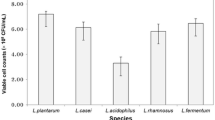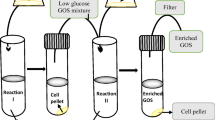Abstract
Isomaltooligosaccharides (IMOs), prebiotic compounds stimulating the growth of intestinal bacteria, were synthesized in sauerkraut by inoculating psychrotrophic Leuconostoc citreum KACC 91035 strain with high dextransucrase activity. For the glucose transferring reaction of dextransucrase, sucrose and maltose were added in sauerkraut (29 and 28 mM, respectively, w/v) as glucosyl donor and acceptor molecule, respectively. For 12 days of fermentation at 10℃, IMOs were gradually produced by consuming sucrose and maltose, and the synthesis rate and maximal concentration of IMOs were 2.04 and 20.2 mM, respectively. This result demonstrates a simple method to manufacture a synbiotic sauerkraut product by adding probiotic lactic acid bacterium and sugars as ingredients.
Similar content being viewed by others
References
Swain MR, Anandharaj M, Ray RC, Praveen-Rani R. Fermented fruits and vegetables of Asia: A potential source of probiotics. Biotechnol. Res. Int. 2014: 250424 (2014)
Plengvidhya V, Breidt Jr F, Fleming H. Use of RAPD-PCR as a method to follow the progress of starter cultures in sauerkraut fermentation. Int. J. Food Microbiol. 93: 287–296 (2004)
Eom HJ, Park JM, Seo MJ, Kim MD, Han NS. Monitoring of Leuconostoc mesenteroides DRC starter in fermented vegetable by random integration of chloramphenicol acetyltransferase gene. J. Ind. Microbiol. Biot. 35: 953–959 (2008)
Chyun JH, Rhee HS. Studies on the volatile fatty acids and carbon dioxide produced in different kimchis. Korean J. Food Sci. Technol. 8: 90–94 (1976)
Robyt JF, Eklund SH. Relative, quantitative effects of acceptors in the reaction of Leuconostoc mesenteroides B-512F dextransucrase. Carbohyd. Res. 121: 279–286 (1983)
Crittenden RG, Playne MJ. Production, properties and applications of food-grade oligosaccharides. Trends Food Sci. Tech. 7: 353–361 (1996)
Kohmoto T, Fukui F, Takaku H, Machida Y, Arai M, Mitsuoka T. Effect of isomalto-oligosaccharides on human fecal flora. Bifidobact. Microflora 7: 61–69 (1988)
Kohmoto T, Fukui F, Takaku H, Mitsuoka T. Dose-response test of isomaltooligosaccharides for increasing fecal bifidobacteria. Agr. Biol. Chem. Tokyo 55: 2157–2159 (1991)
Kaneko T, Kohmoto T, Kikuchi H, Shiota M, Iino T, Mitsuoka T. Effects of isomaltooligosaccharides with different degrees of polymerization on human fecal bifidobacteria. Biosci. Biotech. Bioch. 58: 2288–2290 (1994)
Han NS, Jung Y-S, Eom H-J, Koh Y-H, Robyt JF, Seo J-H. Simultaneous biocatalytic synthesis of panose during lactate fermentation in kimchi. J. Microbiol. Biotechn. 12: 46–52 (2002)
Eom HJ, Seo DM, Han NS. Selection of psychrotrophic Leuconostoc spp. producing highly active dextransucrase from lactate fermented vegetables. Int. J. Food Microbiol. 117: 61–67 (2007)
Cho SK, Eom H-J, Moon JS, Lim S-B, Kim YK, Lee KW, Han NS. An improved process of isomaltooligosaccharide production in kimchi involving the addition of a Leuconostoc starter and sugars. Int. J. Food Microbiol. 170: 61–64 (2014)
Beganoviæ J, Pavunc AL, Gjuraèiæ K, Špoljarec M, Šuškoviæ J, Kos B. Improved sauerkraut production with probiotic strain Lactobacillus plantarum L4 and Leuconostoc mesenteroides LMG 7954. J. Food Sci. 76: 124–129 (2011)
Viander B, Mäki M, Palva A. Impact of low salt concentration, salt quality on natural large-scale sauerkraut fermentation. Food Microbiol. 20: 391–395 (2003)
Plengvidhya V, Breidt Jr F, Lu Z, Fleming HP. DNA fingerprinting of lactic acid bacteria in sauerkraut fermentations. Appl. Environ. Microb. 73: 7697–7702 (2007)
Wang C, Zhang X, Li D, Niu C, Yang Z. Study on the identification and resistant properties of Lactobacillus plantarum isolated from sauerkraut. Food Sci. Technol. 31: 141–144 (2010)
Yang Z, Li S, Zhang X, Zeng X, Li D, Zhao Y, Zhang J. Capsular and slime-polysaccharide production by Lactobacillus rhamnosus JAAS8 isolated from Chinese sauerkraut: Potential application in fermented milk products. J. Biosci. Bioeng. 110: 53–57 (2010)
Author information
Authors and Affiliations
Corresponding author
Rights and permissions
About this article
Cite this article
Cho, S.K., Shin, SY., Lee, S.J. et al. Simple synthesis of isomaltooligosaccharides during Sauerkraut fermentation by addition of Leuconostoc starter and sugars. Food Sci Biotechnol 24, 1443–1446 (2015). https://doi.org/10.1007/s10068-015-0185-x
Received:
Revised:
Accepted:
Published:
Issue Date:
DOI: https://doi.org/10.1007/s10068-015-0185-x




